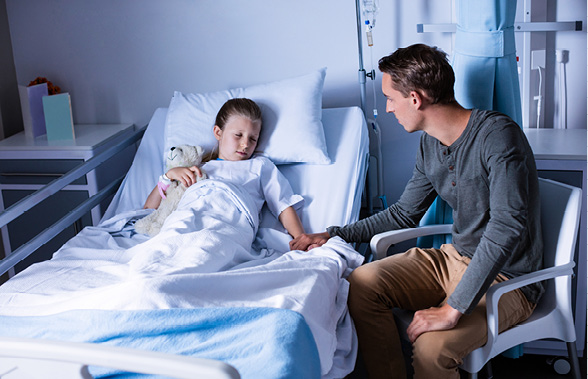Understanding prognosis
Healthcare providers use the term prognosis to describe what they predict may happen to a patient who has an illness or injury.

Healthcare providers use the term prognosis to describe what they predict may happen to a patient who has an illness or injury. A prognosis is an educated prediction based on what healthcare providers know about:
- Your child’s health status, based on information gathered from physical examinations and test results
- The best scientific evidence about how the illness or injury will develop
- The available treatments for the illness or injury
- The experience of the healthcare provider
The term prognosis can be used to talk about your child’s recovery in different ways. Healthcare providers may make estimates about:
- How well your child will be able to function in the future: For example, after a spinal injury, “the prognosis is paralysis from the waist down”, means the patient is not expected to ever walk again. “The prognosis is for full recovery”, means the patient is expected to recover all their usual functions or abilities after a time of healing and rehabilitation.
- How likely it is that your child will be cured: For example, after a cancer diagnosis, “the prognosis is 10% at 5 years”, means there is a 1 in 10 chance that the patient will be alive in 5 years. “The prognosis is excellent”, means the patient is expected to survive this condition.
- How long your child may survive after a diagnosis when there are no treatments available to cure the condition: For example, a degenerative neurologic disease, “the prognosis is 12 to 14 months”, means the patient is only expected to live for 12 more months.
- What condition your child is in: Healthcare providers may use words like, good, fair, serious or critical. When they worry that your child will not recover or survive, but they don’t know more than that, they may say the prognosis is “guarded”. For example, after a major car crash and emergency surgery, “the prognosis is guarded”, means that, although the team has done everything they can, they are not sure that the person will survive.
Prognosis is an educated opinion about how the disease will change. This opinion is based on what the healthcare team knows about your child’s specific health status and about their health condition or conditions. The more information that is available (from reliable sources), the more accurate a prognosis may be.
Healthcare providers can make a relatively accurate prognosis in situations where they have very reliable information even if the information is only about one of either your child’s health status or their condition(s).
- Example 1: A pathologist is studying the cells of David’s brain tumour in the laboratory. She identifies it as a rare tumour called an ExBT. She consults the medical literature and finds that patients diagnosed with this tumour die within 1 year. Treatment may slow the growth of the tumour, but no one has ever been reported as surviving beyond a year. She consults with two other specialists who agree with her findings that David’s tumour is an ExBT. Although she has very little information about David’s current health status, this pathologist has enough information about ExBT to expect that David will, sadly, die within one years’ time.
- Example 2: Shawna has an extremely rare condition called Examedsyn syndrome, about which very little is known or understood. At 8 years old, she has no teeth and her dentist does an x-ray and sees no developing teeth. Despite knowing very little about Examedsyn syndrome, her dentist informs the family she will likely never grow teeth. In this scenario, although very little is known about the Examedsyn, the dentist has enough information about the girl’s health status to make a reliable prediction for the future.
Many people feel that a prognosis is something final that won’t change. However, as time passes and as more information becomes available, the best estimate of your child’s future health may change, at times for better and at times for worse.
- Example: Twin siblings (Abigail and Andrew) are diagnosed with the same heart condition that requires surgical correction. The family is told that 75% of patients with this condition (3 out of 4) survive the surgical procedure and the recovery period. Both children have a prognosis for survival of 75%. Abigail’s surgery goes very smoothly and she has an uncomplicated recovery. Her new prognosis for survival is now near 100%. Unfortunately, Andrew’s surgery was more complicated and he now requires a second surgery for survival. The cardiac surgeon informs the family that only 20% of children survive this second surgery (1 out of 5). Andrew’s prognosis for survival, therefore, is now 20%.
A prognosis tries to predict what might happen. But for many families, it does not matter what might happen; only what does happen.
- Example: A new medication called al-BLUE-terol has a 1% chance of turning skin permanently blue. 100 patients use the medication in a study, and 1 has their skin turn blue. For 99 patients, it did not really matter that they had a 1% chance of turning blue, because, in the end, they were not blue. But for 1 patient, who was blue from head to toe, it mattered a great deal.
Some health practitioners and families try not to use specific numbers or percentages when they talk about prognosis. Ultimately, these numbers come from medical research and evidence-based practice, which is based on other patients’ experiences. These numbers change over time and as more information becomes available.
What matters most
When your child has a serious illness, it’s most important to understand:
- How severe is the illness or condition
- How the illness or condition usually changes over time
- What treatment options are available
- What are the risks and benefits of treatment
- How likely those treatments are to work
After you talk about all of these factors, you and your healthcare team can use the information to make the best plan possible for your child. The plan should be reviewed often, whenever new information becomes available or whenever changes are needed to meet the goals of care.
Read more












